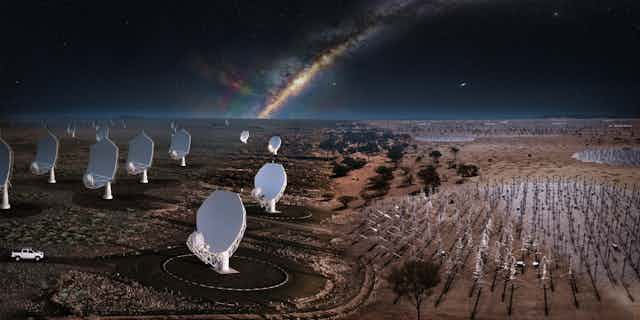Canada is about to become a member of the Square Kilometre Array Observatory (SKAO) — the world’s next giant radio telescope. This is a win for all Canadians, not just astronomers.
SKAO is a radio telescope made up of thousands of individual elements over vast areas. Its two remote sites are located, in partnership with local and Indigenous communities, in the Karoo desert region of South Africa and the traditional lands of the Wajarri Yamaji in outback Western Australia.
An international partnership that will operate the observatory includes 16 countries located on five continents.
Radio observations
Observing the sky with radio telescopes is not just (or even mostly) about looking for aliens. Electromagnetic radiation at radio wavelengths is produced by some of the most interesting and mysterious objects in the universe. These range from the supermassive black holes at the hearts of distant galaxies to pulsars that spin at dizzying rates like the fastest lighthouses, to the baffling explosions that produce fast radio bursts.
To detect these faint signals when they reach Earth, we need many sophisticated antennas spread over large geographical areas, and located in places far from human-generated interference.
Canadian involvement
Canadian scientists are involved in many international projects, including the Large Hadron Collider in Geneva, Switzerland and SNOLAB underground laboratory in Lively, Ont..
The Canadian Astronomical Society makes recommendations on telescope participation through a decade long range plan in which the professional astronomy community considers its priorities. Full participation in the SKA was the highest priority among large projects of the most recent plan that covers 2020 to 2030.
Canada has already been a key partner in the SKA project for over 20 years, making contributions to both the technical and scientific designs. There is no other existing or planned telescope like the SKAO, and not participating would have meant that Canadian astronomers would miss out.
Canadian leadership
Canadian astronomy, despite its small size, is a world leader. We already conduct research with radio astronomy facilities such as the CHIME experiment near Penticton, B.C., Atacama Large Millimeter/submillimeter Array in Chile and the Jansky Very Large Array in New Mexico. Participation in the SKAO will allow us to keep making new discoveries, thanks to one of the largest Canadian investments in astronomy to date.

Canada’s membership in the SKAO will allow Canadian companies to bid on shares of the work to be done for this billion-dollar mega science project. Technologies developed for the project will include computer hardware for digital signal processing and antenna dishes that can be mass produced of composite materials. These technologies may have applications in other industries. There is also the opportunity to strengthen Canada’s innovation culture and international reputation as a technology leader.
Once at full operation, the SKAO will produce a data firehose: 300 petabytes, or about half a million typical laptop hard drives, per year. Developing the computer hardware and software for processing the SKA data will be another technological win for Canada: the algorithms and know-how needed can be adapted for big data applications elsewhere, from climate modelling to epidemiological research.
Future generations
SKAO is not just another radio telescope. Construction will be completed in 2029, with significant Canadian contributions. Membership in SKAO will also attract and train the next generation of Canadian scientists and engineers.
The excitement of space attracts many youth to STEM careers, and those who choose to study astronomy will have the opportunity to work with cutting-edge hardware and vast amounts of data. Some of those graduates will go on to work in astronomy research, while others will apply their skills to careers in finance, health care or environmental monitoring and protection. This will help build Canada’s capacity for innovation in a technologically driven future.

